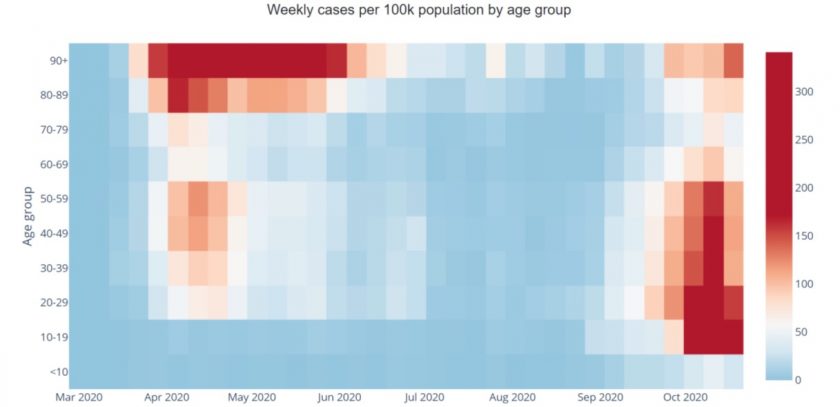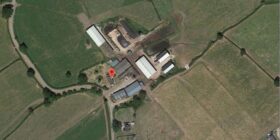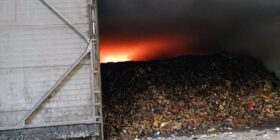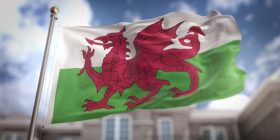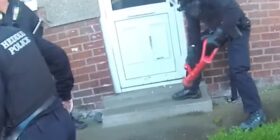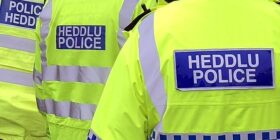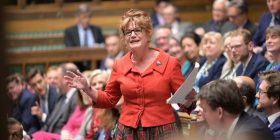“Firebreak will reset the clock” as scientific advice published explaining it could help put pandemic back a month or more
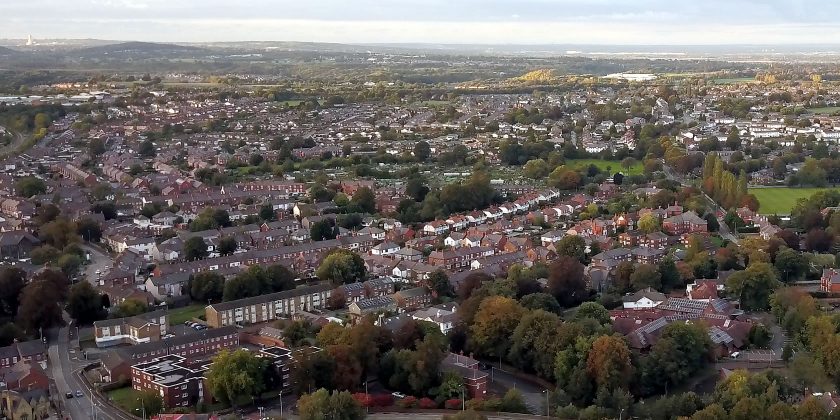
Wales’ First Minister has said he cannot rule out introducing any further “short, sharp” measures to tackle coronavirus over the coming months as the scientific advise behind the measure has been published.
On Friday at 6pm Wales will begin a two week “fire-break” which, like March, will see people required to stay home and the closure of all non-essential retail, hospitality, including cafes, restaurants and pubs (unless they provide take-away or delivery services), close contact services, such as hairdressers and beauticians, and events and tourism businesses, such as hotels.
Where possible people will be asked to work from home and to not visit other households or meet other people they do not live with either indoors and outdoors.
No gatherings will be allowed outdoors, such as Halloween or fireworks/Bonfire night or other organised activities and community centres, libraries and recycling centres will be required to close.
Also during the two week period:
- Adults living alone or single parents will be able to join with one other household for support
- Primary and special schools will re-open as normal after half-term
- Secondary schools will re-open after the half-term for children in years seven and eight and most vulnerable children. Pupils will be able to come in to take exams but other pupils will continue their learning from home for an extra week
- Universities will provide a blend of in-person and online learning
- NHS and health services will continue to operate
- Local parks, playgrounds and outdoor gyms will remain open
These measures will remain in place until Monday 9th November. Following the end of the fire-break, a new set of national rules will be introduced, covering how people can meet and how the public sector and businesses operate.
Speaking yesterday First Minister Mark Drakeford said the “short and sharp” measures were being introduced due to an increase in coronavirus cases in Wales.
The R number is currently between 1.1 and 1.4, meaning continued exponential growth in the number of cases and the seven-day rolling incidence rate for Wales stands at more than 130 cases per 100,000 population.
However the First Minister noted that it was unlikely that any drop in the infection rate would not be noticeable until after the fixed two week period.
Asked if he could guarantee that similar fire-break measures won’t be introduced again in the coming months, the First Minister said he could not rule anything out.
He said: “I’m not in the business of giving guarantees that nobody could possibly be sure they could keep.
“Nor can I rule out further measures into next year if the virus were to come back and be spreading at the velocity that it is spreading today.”
“The aim of the fire-break period, is to get us through to Christmas without the need for restrictions of this sort.”
“There will be regime the other side of it, as I’ve said, but the aim of a firebreak is to reset the clock and to allow us to get through to Christmas together.”
“Beyond that it simply wouldn’t be sensible given the speed at which things change, the nature of the virus we face, to be offering people guarantees of how the future may unfold.”
The Technical Advisory Cell document related to the decision has also now been published (full PDF here) where the summary says, “The paper recommends a 2-3 week hard fire break to bring R below 1 in order to both lessen the impact and slow the growth of the epidemic in Wales.”
The report contains one of the first age group data visualisations for Wales, explaining “As reported by Public Health Wales, incidence has increased across all age groups, and is highest in those aged under 50.”
The graphic above shows the increasing proportion of cases (shown in darker red) now seen in older age groups, “There has been a clear pattern from around the world of incidence rising first in young people, before spreading into older age groups. No country has managed to contain their epidemic within lower risk age groups. This is a result of there being substantial interaction between older people and all other age groups, as demonstrated by studies of contact patterns.”
Hospital admission data is also included, with the below graph showing increasing numbers of people admitted to hospital that are either suspected or confirmed as having Covid-19. The purple line represents the total number over a rolling 7 day average, whilst the fainter grey lines show the actual figures at that time.
A month ago a Technical Advisory Cell document published a set of modelling (story here via North.Wales) that predicted what could happen during a second wave, which was titled ‘Reasonable Worst Case’. The new document yesterday states, “We are currently tracking to our Reasonable Worst Case (RWC) that projects around 18,000 hospitalisations and 6,000 deaths due to Covid-19 over the winter period”.
Back in July another Technical Advisory Cell document referred to a range of ‘circuit breakers’ that were explained as being triggers for future lockdowns (story here), and the new document lists through them explaining which have been exceeded. These include the ‘R’ figure, cases per 100k figures, positivity rates of testing, hospital occupancy and other indicators.
The new document then goes on to examine the effect of local lockdowns which the Technical Advisory Cell say “has led to a significant slowdown in the current wave of the pandemic”, although a range of indicator data points to “compliance with the restrictions in place is waning”. Although there has been an impact, it has not driven the “R” figure down enough, and therefore “growth of infections is still ultimately following an exponential course”.
The document argues that the ongoing growth of the virus can itself cause ‘anxiety and mistrust’ as the actions taken appear not to be effective, which itself “leads to a vicious circle of reduction in adherence”.
Examination of ‘wastewater’, or what goes down your toilet, and a range of genomic sequencing of virus samples say that there is a relatively diverse seeding of the virus, with a specific mention of “seeding from areas of high incidence in the North West of England has penetrated as far as the Llyn Peninsula”. That pattern follows a report from the Technical Advisory Cell that said the virus spread in the first wave through North Wales from Chester / Merseyside / Manchester directions.
The Technical Advisory Cell discuss the harms a lockdown could create, “Both intervening and not intervening will cause harm: long and short-term harms, direct and indirect harms, economic harms, social and psychological harms and health harms. There could be a disproportionate impact on many different groups of people and it will be vital to mitigate against as many of the harms as possible. ”
It explains, “From an economic perspective, preventing transmission is less important than maintaining an effective workforce and infrastructure. Limiting the size of a pandemic related recession will save lives in the future as mortality is closely related to income and life chances.”
“Behavioural insights show that many measures will only work if the public are engaged, agree and understand that Covid-19 is a serious health threat that must be managed”.
No action is effectively ruled out, “There is a reasonable likelihood that if we do not act now, we will need to take further, more expensive and longer action in the future to achieve a similar reduction. The scale of the negative impact on the NHS in Wales is growing by the day. There is a high confidence that cases and hospital admissions in Wales is leading to a deterioration in our capacity to treat non-Covid-related physical and mental health issues”.
The impact of a fire break is described as “could put the epidemic back by approximately 28 days or more”, however only if it were as strict and well-adhered to as the restrictions in late May.
Giving an insight to the grim decisions having to be made the latest advice document contains the latest Swansea University generated Reasonable Worst Case model, which has been interrogated to generate estimate of impacts on health and NHS provision for a two and three week fire break. The above graph shows the output, with no change there could be 2,500 deaths by the end of the year, a two week firebreak could see that reduce to 1,540 and a three week break is modelled at 1,200 lives lost.
The document rounds up with a recommendation for a a two-phase approach, explained as the below, as “Without intervention, continued increase of cases of Covid-19 in Wales, in hospitals and in ICU will be too high for the NHS to sustain.”:
- The first phase is a “fire-break” – a swiftand short-term period of simple, extreme restrictions across the whole of Wales that would significantly reduce the prevalence of the virus in Wales. This would ease the pressure on the NHS and offer some time for a reset of behaviours and implementation of new healthcare pathways, health protection approaches or other interventions that require a runup. Doing it over half term would reduce financial and social harms.
- The second phase is a new, simpler, national approach to behaviours and restrictions. Simpler messaging and regulations are expected to be easier to understand and comply with. Some existing restrictions may be removed if they are shown to be less effective or more harmful than originally expected, such as the Local Authority travel boundary restrictions. However, there would need to be sustainable changes in behaviour in many areas of life in order for Rt to remain as near to 1 as possible
You can find the surprisingly easy to read Technical Advisory Cell document here, and you can read previous outputs from the group here.
Welsh Government have created a big Frequently Asked Question and Answer page on their site – covering a range of common questions (and answers) over the forthcoming ‘firebreak’ lockdown – you can view that here.
Spotted something? Got a story? Email [email protected]
